Geography of Arkansas
The geography of Arkansas varies widely. The state is covered by mountains, river valleys, forests, lakes, and bayous in addition to the cities of Arkansas. Hot Springs National Park features bubbling springs of hot water, formerly sought across the country for their healing properties.[1][2] Crowley's Ridge is a geological anomaly rising above the surrounding lowlands of the Mississippi embayment.
The Buffalo National River, as it flows through The Ozarks to the White River, is a popular tourist attraction. It was designated the first national river in 1972 after years of conservation efforts in opposition to a United States Army Corps of Engineers plan to dam the river. The Arkansas River enters the state near Van Buren and flows southeast through Little Rock to empty into the Mississippi River near Arkansas Post. Most of the river serves barge traffic to Tulsa, Oklahoma as the McClellan–Kerr Arkansas River Navigation System.[3] Through south Arkansas, the Ouachita River and the Saline River run roughly parallel to the Arkansas, and the major rivers in northeast Arkansas are the White River and St. Francis River. The Red River runs through the southwest corner of the state.
Arkansas has many manmade lakes across the state, many are the basis for state parks, wildlife management areas, or other recreation. Bull Shoals Lake, DeGray Lake, Lake Dardanelle, Lake Ouachita all have state parks along their shores, and Beaver Lake, Table Rock Lake, Greers Ferry Lake, Lake Hamilton and Lake Catherine are also major recreation lakes in the state.[4]
The Ozarks is a broad term for many mountainous counties in northwest Arkansas. This region is usually referred to the Ozarks because the term Northwest Arkansas is the colloquial name for the Fayetteville–Springdale–Rogers Metropolitan Area, including Benton, Madison, Washington counties in Arkansas and McDonald County, Missouri.[5] The Ozark, however, span from the Arkansas River in the south through north central Arkansas. The Boston Mountains subset contain highest peaks in the Ozarks.[6]
Location and size
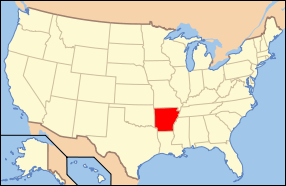
Arkansas is located in the southeastern United States, in the West South Central Census Bureau division. Arkansas covers an area of 53,179 square miles (137,733 km²) and ranks as the 29th largest state by size.[7] The state borders six U.S. states: Missouri to the north, Tennessee and Mississippi across the Mississippi River to the east, Louisiana to the south, Oklahoma to the west, and Texas to the southwest.
First added to the United States of America as part of the Louisiana Territory of the Louisiana Purchase in 1803, Arkansas later became part of the Missouri Territory upon its establishment in 1812.[8] This was further divided into the Arkansaw Territory on March 2, 1819 as everything south of Parallel 36°30′ north (except the Missouri Bootheel) to the Louisiana state line. This new territory also included most of present-day Oklahoma until gaining its current boundaries in the 1840s. The slight oddity in Arkansas's western boundary results from a dispute with the Choctaw Nation in 1824. The Choctaws wanted the western boundary of Arkansas to start 100 paces east of Fort Smith and run south to the Red River, claiming the land had little timber and poor soil. Despite protests from Henry Conway, President James Monroe signed the bill into law on January 20, 1825.[9]
Regions
| Part of a series on |
| Regions of Arkansas |
|---|
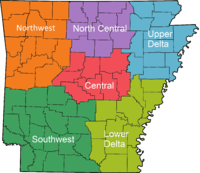 |
|
Geographic Regions |
|
Administrative divisions
|
Arkansas's regions are defined using many different criteria. Distinct natural regions of Arkansas include The Ozarks, Ouachita Mountains, Arkansas River Valley, Gulf Coastal Plain, Crowley's Ridge, the Arkansas Delta, Arkansas Timberlands, and Central Arkansas. Arkansans usually identify as being from one of five regions: northwest, southwest, northeast, southeast, or central Arkansas. These directional regions are not specifically defined by county.
Northwest Arkansas
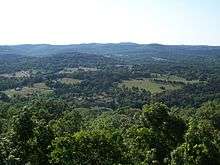
Northwest Arkansas contains the southern half of the Ozarks, including the steeper Boston Mountains and the more gentle Springfield Plateau. These mountains are heavily forested by an oak-hickory ecosystem and less than 25% has been cleared for agriculture.[10] The Ozark National Forest, administered by the National Forest Service, preserves 1,200,000 acres (490,000 ha) of land in northwest Arkansas, including Arkansas's highest point, Mount Magazine in Mount Magazine State Park. Also within northwest Arkansas is the Arkansas River Valley including the tri-peaks tourist region of Mount Nebo, Mount Magazine, Petit Jean Mountain, and Lake Dardanelle.[11] Federal and state protected areas such as the Buffalo National River, Buffalo National River Wilderness, Bull Shoals–White River State Park, and Hobbs State Park – Conservation Area preserve the northwest Arkansas Ozarks in their natural state.
Population is anchored by the Fayetteville–Springdale–Rogers Metropolitan Area and Fort Smith metropolitan area, with sparsely populated mountainous areas defining the remainder of the region. The Ozark culture, such as Ozark Folk Festival held annually in Mountain View, defines much of the rural parts of northwest Arkansas. The Ozark Folk Center in Mountain View is dedicated to preserving northwest Arkansas's folk heritage.[12] Other cultural centers are Bentonville, home to Crystal Bridges Museum of American Art, and Fayetteville, home to the University of Arkansas and Walton Arts Center.[13]
Northeast Arkansas
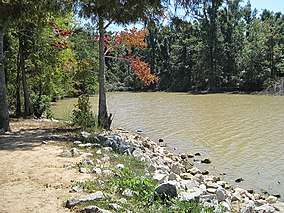
Northeast Arkansas is generally characterized as the area east of the Ozark Mountains and north of Interstate 40. The land is adjacent to the Mississippi River and generally flat, fertile, swampy lands sometimes called the Arkansas delta. The exception is Crowley's Ridge, a geological remnant from the Pleistocene era that raises around 200 feet (61 m) above the surrounding delta lowlands.[14] Crowley's Ridge is more populated than the sparsely populated delta, including larger cities Jonesboro, Paragould, Forrest City, and Wynne. Primary waterways in the region include the Cache River, St. Francis River, and the Black River. Protected areas of northeast Arkansas include Cache River National Wildlife Refuge, Bald Knob National Wildlife Refuge, Wapanocca National Wildlife Refuge, Lake Charles State Park, and Lake Poinsett State Park.
Tourists can explore some of the local Native American culture at the Nodena Site, Parkin Archaeological State Park, and Hampson Museum State Park. Following settlement, most of the area relied on cotton as the primary cash crop, and was home to many powerful plantation owners in the antebellum period. After the Civil War, agriculture became based on sharecropping and tenant farming, allowing plantation owners to keep their workers in poverty and maintain their political power. Much of this history is alive today at museums like the Southern Tenant Farmers Union Museum in Tyronza. The rivers served as highways for commerce and communication in the early days, and steamboat towns of days past have been restored for visitors to enjoy, including Jacksonport State Park and Powhatan Historic State Park along the Black River. Davidsonville Historic State Park preserves one of the state's first settlements as a frontier town, also located on the Black River. The primary population center of the region is the Jonesboro metropolitan area, with Jonesboro serving as the principal city.
Southeast Arkansas
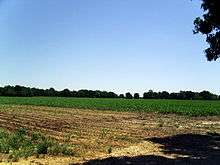
Southeast Arkansas is generally characterized as the area east of Little Rock and south of Interstate 40. The land is adjacent to the Mississippi River and generally flat, fertile, swampy lands sometimes called the Arkansas delta. This region is sparsely populated, with an economy primarily driven by agriculture. The western side of Southeast Arkansas includes the Piney Woods, a region known for dense pine and cypress forests. Silviculture and agriculture are prominent in this section of the region. Population centers include Pine Bluff, Stuttgart, Monticello, Warren and Crossett. Primary waterways in the region include the Arkansas River, Bayou Bartholomew, Mississippi River and the White River. Protected areas of southeast Arkansas include Cane Creek State Park, Delta Heritage Trail State Park, Felsenthal National Wildlife Refuge, Lake Chicot State Park, Mississippi River State Park, Overflow National Wildlife Refuge and White River National Wildlife Refuge.
The flat topography and fertile soils of Southeast Arkansas have been important to the region throughout its history, first to the Native American that inhabited the region. This history is available today at museums like the Pine Bluff/Jefferson County Historical Museum. The area was one of the first explored and settled in Arkansas; including the territorial capital at Arkansas Post. Following widespread settlement, most of the area was put into cotton cultivation due to the region's fertile soils. The staple's high market value made many plantation owners wealthy in the antebellum period; this history is available to visitors at museums such as the Lakeport Plantation. After the Civil War, agriculture became based on sharecropping and tenant farming, allowing plantation owners to keep their workers in poverty and maintain their political power and social dominance. In the 1950s, mechanization reduced the need for laborers on the farm, driving much of the region's population elsewhere in order to find jobs. Throughout much of Southeast Arkansas, population has continued to decline and economies have continued to shrink ever since. The primary population center of the region is the Pine Bluff metropolitan area, with Pine Bluff serving as the principal city.
Southwest Arkansas
Southwest Arkansas is largely covered in a thick pine, hickory, and oak forest known as the Piney Woods, with much of the land being preserved in the Ouachita National Forest. Manmade lakes dot the region, including Lake Ouachita, Lake Hamilton, Millwood Lake, and DeGray Lake. Population centers include Hot Springs, a popular tourist destination known for the natural hot springs protected within Hot Springs National Park, Oaklawn Park, and historic buildings, and Texarkana, which straddles the Texas state line in the southwest corner of Arkansas. Most of Southwest Arkansas is sparsely populated, with small towns separated by long roadways through stands of pine trees.
Hydrology
Rainfall in Arkansas is split almost in half along a northeast/southwest dividing line by the Natural Resources Conservation Service, with the northeast being characterized as arid-semiarid climate and the southwest being a Gulf-influenced humid-subhumid climate.[15] The area that receives the most rain in the state is the area south of the Ouachita Mountains, which forms an orographic effect (commonly known as rain shadow) when storms move north from the Gulf.
The Arkansas Department of Environmental Quality (ADEQ) also describes Arkansas's water resources using six ecoregions. Of the six, the Boston Mountain, Ouachita Mountain and Ozark Highlands ecoregions generally contain waterways with "exceptionally high quality water", including many of the state's extraordinary resources waters (ERWs). The Arkansas River Valley, Gulf Coastal and Delta ecoregions have seen water quality impacts from agriculture and silviculture but are generally compliant with the goals of the Clean Water Act.[16]
Surface water
Arkansas contains approximately 515,000 acres (208,000 ha) of surface waters, including 28,408 miles (45,718 km) of perennial streams and 87,618 miles (141,008 km) of total streams. ADEQ uses six ultimate receiving streams to subdivide the state into primary watersheds: Arkansas River, Mississippi River, Ouachita River, Red River, St. Francis River, and White River. This six basins collect water from over 1600 smaller watersheds throughout the state via tributary streams, as described below.[16]
- Arkansas River: flows south-southeast, roughly bisecting the state. Major tributaries include Bayou Meto, Cadron Creek, Fourche LaFave River, Petit Jean River, Poteau River and Illinois River.
- Mississippi River: flows south and forms much of the state's eastern boundary on its way to the Gulf of Mexico. Major tributaries include the Arkansas, St. Francis, and White.
- Ouachita River: flows southeast into Louisiana. Major tributaries include the Antoine River, Boeuf River, Bayou Bartholomew, Little Missouri River, and the Saline River.
- Red River: located in southwest Arkansas, flows southeast into Louisiana. Major tributaries include: Dorcheat Bayou, Bodcau Bayou, Lower Middle Red River, Lower Red River, Sulphur River, McKinney Bayou, Little River, and Mountain Fork
- St. Francis River: located in northeast Arkansas, flows east into the Mississippi River. Major tributaries include the L'Anguille River and Little River.
- White River: flows from northwest to southeast Arkansas, including a brief turn into Missouri. Major tributaries include Bayou De View, Bayou des Arc, Black River, Buffalo River, Cache River, Eleven Point River, Kings River, Little Red River, Spring River, Strawberry River, Village Creek, Wattensaw Bayou.
 Arkansas River
Arkansas River
at Little Rock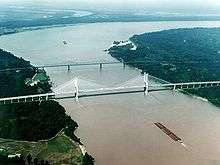 Mississippi River
Mississippi River
at Lake Village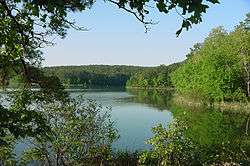 Ouachita River in the
Ouachita River in the
Ouachita National Forest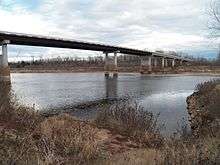 Red River
Red River
at Lewisville St. Francis River
St. Francis River
at Parkin White River
White River
at Buffalo City
Groundwater
Groundwater accounts for over 60% of water use in Arkansas, and shallow aquifers providing high quality groundwater can be found throughout the state. In many upland regions of Arkansas, surface water interacts with groundwater via karst topography common to the Ozarks and Ouachitas. Groundwater monitoring is subdivided into twelve areas. Of the twelve, the Athens Plateau (Hempstead County), Frontal Ouachita, Hardy, Omaha, Ouachita, North Central, and Pine Bluff monitoring areas have a water quality described as "generally good".
Protected areas
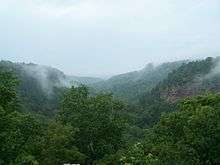
Arkansas has many protected natural areas administered by several different organizations. The Ozark Mountain forests have been subdivided into the Ozark National Forest, St. Francis National Forest, and the Ouachita National Forest, maintained by the United States Forest Service.[17][18] The Forest Service also maintains the Black Fork Mountain Wilderness, Blanchard Springs Caverns, and several other recreational areas within the forests.
Administered by the National Park Service (NPS), Hot Springs National Park was the nation's first national park. The park includes Bathhouse Row, a formerly bustling avenue of Gilded Age architecture bathhouses which used the spring water to cure dozens of ailments. The NPS also maintains three National Historic Sites in Arkansas: Fort Smith National Historic Site, Little Rock Central High School, and the President Clinton Birthplace. Pea Ridge National Military Park is the only National Military Park, and Arkansas Post National Memorial is the lone National Memorial in the state.
The Arkansas Department of Parks and Tourism maintains 52 state parks in Arkansas as well as Poison Springs State Forest.[4] Parks range from large forested areas for hiking enthusiasts, to lakes and rivers for watersports, to interpretive historical sites, to cemeteries celebrating historically significant Arkansans. Some of the most frequently visited parks include Mount Magazine State Park, DeGray Lake Resort State Park, Crater of Diamonds State Park, Pinnacle Mountain State Park, Petit Jean State Park, Devil's Den State Park, Crowley's Ridge State Park, and Lake Ouachita State Park.
References
- "Hot Springs National Park". National Park Service. February 14, 2012. Retrieved February 18, 2012.
- Bryan, Kirk (August–September 1922). "The Hot Water Supply of the Hot Springs, Arkansas". The Journal of Geology. The University of Chicago Press. 30 (6): 425–449. doi:10.1086/622931. OCLC 30653669.
- "What is the McClellan-Kerr Arkansas River Navigation System?". U.S. Army Corps of Engineers. April 26, 2010. Archived from the original on August 5, 2012. Retrieved February 18, 2012.
- Arkansas State Parks Guide, 2011. Arkansas Department of Parks and Tourism. Retrieved February 18, 2012.
- Metropolitan and Micropolitan Statistical Areas of the United States and Puerto Rico, December 2009 (PDF) (Map). Cartography by Geography Division. United States Census Bureau Economics and Statistics Administration. August 31, 2010.
- Purdue, A. H. (November–December 1901). "Physiography of the Boston Mountains, Arkansas". 9 (8). The University of Chicago Press: 694–701. OCLC 41344070. Cite journal requires
|journal=(help) - "Land and Water Area of States (2000)". www.infoplease.com. Retrieved January 29, 2012.
- Bright, William (Winter 2003). "Native American Placenames in the Louisiana Purchase". American Speech. Project Muse. 78 (4): 354–355. doi:10.1215/00031283-78-4-353. ISSN 0003-1283. OCLC 364753642.
- White, Lonnie J. (Autumn 1962). "Arkansas Territorial Indian Affairs". Arkansas Historical Quarterly. Arkansas Historical Association. 21: 202.
- "Primary Distinguishing Characteristics of Level III Ecoregions of the Continental United States". U.S. Environmental Protection Agency. April 2000. Retrieved March 14, 2012.
- "Arkansas River Valley Tri-Peaks Region". Arkansas River Valley Tri-Peaks Association. 2011. Retrieved March 14, 2012.
- "Ozark Folk Center". Arkansas State Parks Guide, 2011. Arkansas Department of Parks and Tourism. p. 57. Retrieved March 14, 2012.
- "What to Do: Culture Abounds in Northwest Arkansas". Arkansas Business Limited Partnership. January 1, 2010. Retrieved March 14, 2012.
- "Regions - Crowley's Ridge". The Department of Arkansas Heritage. 2012. Retrieved April 28, 2012.
- Brown, S.A.; Schall, J.D.; Morris, J.L.; Doherty, C.L.; Stein, S.M.; Warner, J.C. (September 2009). "Synthetic Rainfall Events". Urban Drainage Design Manual, Hydraulic Engineering Circular 22 (Third ed.). Fort Collins, Colorado: United States Department of Transportation, Federal Highway Administration. Figure 3-4. Retrieved February 1, 2013.
- Arkansas Department of Environmental Quality (2014). "Integrated Water Quality Monitoring Assessment Report" (PDF). Retrieved May 4, 2014.
- "About the Ozark – St. Francis National Forests". United States Department of Agriculture - United States Forest Service. Retrieved February 18, 2012.
- "About the Ouachita National Forest". United States Department of Agriculture - United States Forest Service. Retrieved February 18, 2012.
